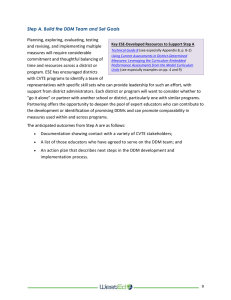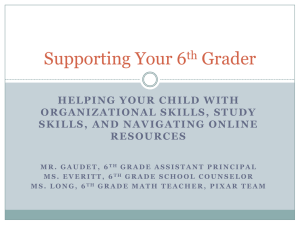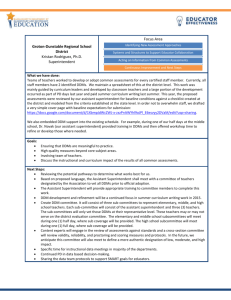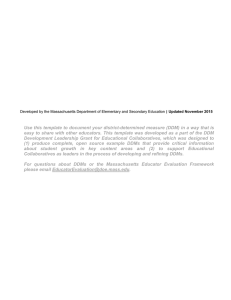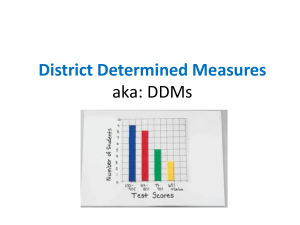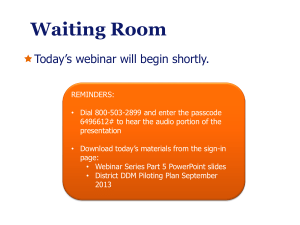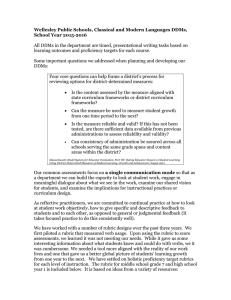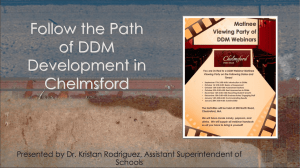Part4
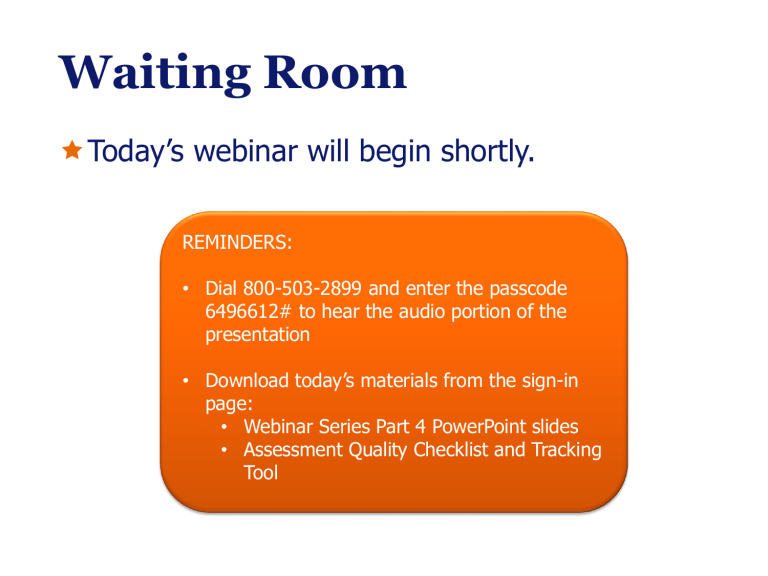
Waiting Room
Today’s webinar will begin shortly.
REMINDERS:
• Dial 800-503-2899 and enter the passcode
6496612# to hear the audio portion of the presentation
• Download today’s materials from the sign-in page:
• Webinar Series Part 4 PowerPoint slides
• Assessment Quality Checklist and Tracking
Tool
Determining the
Best Approach to
District-Determined
Measures
Webinar Series Part 4
Logistics
Q&A
Type your questions into the chat box in the lower right corner of the screen
Recording
Recordings will be archived on our webpage: http://www.doe.mass.edu/edeval/ddm/webinar.html
Supplemental materials
All materials needed to participate in each session will be posted on the sign-in page and archived on our webpage.
2
1
2
3
5
6
7
8
4
Webinar Series
Title
Introduction: District-Determined Measures and
Assessment Literacy
Basics of Assessment
Assessment Options
TA and Networking Session I
Determining the Best Approach to District-
Determined Measures
Integrating Assessments into Educator Evaluation:
Considerations for Measuring Student Growth
TA and Networking Session II
Integrating Assessments into Educator Evaluation:
Developing Business Rules and Engaging Staff
Communicating Results
TA and Networking Session III
Sustainability
Date
3/14
4/4
4/25
7/11
7/18
8/15
9/19
10/24
12/5
12/12
1/23
Length
60 minutes
90 minutes
60 minutes
3 hours
60 minutes
Time
4-5pm
4-5:30pm
4-5pm
9am-12pm
4-5pm
60 minutes
3 hours
60 minutes
60 minutes
3 hours
60 minutes
4-5pm
9am-12pm
4-5pm
4-5pm
9am-12pm
4-5pm
Audience & Purpose
Target audience
District teams that will be engaged in the work of identifying and selecting District-Determined
Measures
Purpose
Participants will:
Learn about various approaches to filling gaps in
District-Determined Measures
Learn about the benefits and challenges of the various approaches 4
Agenda
Debrief of TA & Networking Sessions
Approaches to Filling Gaps in DDMs
Selecting an Approach
Cataloguing Potential DDMs
Pilot Testing
Q&A and Next Steps
5
Debrief of TA & Networking Sessions
July 11, 2013, 9:00am – 12:00pm
East: Norwell
Central: Fitchburg
West: Holyoke
Opportunities to discuss DDM pilot plans and network with colleagues
DDM Stakeholder Engagement
I am the team.
llllllllll
We have a districtlevel team in place.
lllllllllllll llllll
We have engaged school-level educators.
llllllllll
We have engaged educators from the school and district representing numerous roles, grades, and content areas.
We have engaged representatives from most/all school and district roles as well as colleagues in other districts.
lllllll lllllllllllll lllll
6
Debrief of TA & Networking Sessions
DDM Pilot and Implementation Planning
DDWhat?
llll
We have a planning team in place.
llllllllll lllllllll
We’ve started to inventory current assessments and identify gaps.
We have identified
DDMs to pilot in at least the 5 min. areas.
We have already piloted some DDMs.
llllll
We are ready to implement
(at least some)
DDMs!
llllllllll lll llllllllll llll llllllllll llllllllll llllllllll lllllllll
7
Agenda
Debrief of TA & Networking Sessions
Approaches to Filling Gaps in DDMs
Selecting an Approach
Cataloguing Potential DDMs
Pilot Testing
Q&A and Next Steps
8
Approaches to Filling Gaps
Build: developing all components of the assessment (e.g., test specifications
(blueprint), instrument, scoring method) “from scratch”
Borrow: acquiring an existing assessment from another district, state, or other organization for use “as is”
Buy: purchasing a commercially available assessment for use “as is”
9
Build, Borrow, or Buy Overview
Each approach has benefits and challenges
One approach may not be the right choice for all grades/subjects or courses
Choice should be based on local needs and context
Most districts will use a hybrid approach
Building an assessment from scratch and borrowing or buying the ‘perfect, ready-made’ assessment represent opposite ends on a continuum
There are a many, varied hybrid approaches that fall between these opposite ends of the continuum 10
Build, Borrow, Buy…or a Hybrid Approach
Build
From Scratch:
Building a completely new assessment from the ground up
Hybrid Approach:
Some combination of building from scratch and borrowing/buying
Borrow or Buy
May include building components from scratch, using components as is, and/or modifying components to meet your needs
From Elsewhere: acquiring at no cost or purchasing an existing assessment from another source for use as is
11
Agenda
Debrief of TA & Networking Sessions
Approaches to Filling Gaps in DDMs
Selecting an Approach
Cataloguing Potential DDMs
Pilot Testing
Q&A and Next Steps
12
Discussion Points
Engage Educators
Identify Content
Defining the Assessment
Evaluate Utility and Technical Quality
Communicate Results
Monitor DDM’s Use
13
Engage Educators
The district team needs to engage educators in
DDM process:
Build: engage educators to build components
Borrow/Buy: engage educators to evaluate components
Hybrid: the amount of educator engagement depends on where your district team is positioned on the continuum
14
Identify Content
The district team needs to identify content to be captured in an assessment:
Build: use curriculum framework to build detailed test specifications
Borrow/Buy: evaluate alignment of existing content to curriculum framework
Hybrid: the content to be identified depends on where your district is positioned on the continuum
15
Defining the Assessment
The district team typically needs to define the same components for each assessment (e.g., instrument, administration protocol, scoring method--See Technical Guide A):
Build: build all components from scratch
Borrow/Buy: some or most components likely already exist but still need to be evaluated
Hybrid: Some components may be needed depending on where your district is positioned on the continuum
16
Evaluate Utility and Technical
Quality
The district team needs to evaluate utility and technical quality of an assessment:
Build: must establish evidence of quality over time
Borrow/Buy: information about quality may already exist, but still need to evaluate
Hybrid: evaluating utility and technical quality will vary depending on where your district is positioned on the continuum
17
Communicate Results
The district team needs to communicate the results of an assessment:
Build: must determine audiences and create reporting methods audiences
Borrow/Buy: reporting methods may already exist (for some/all audiences), but may need to create and/or evaluate
Hybrid: what and how much is communicated depends on where your district is positioned on the continuum 18
Monitor DDM’s Use
The district team needs to monitor (evaluate data) and maintain (revise and improve) an assessment:
Build: needs to include gathering data to assess quality from scratch
Borrow/Buy: monitoring will still be required but likely there is a starting point
Hybrid: monitoring an assessment depends on where your district is positioned on the continuum
19
Agenda
Debrief of TA & Networking Sessions
Approaches to Filling Gaps in DDMs
Selecting an Approach
Cataloguing Potential DDMs
Pilot Testing
Q&A and Next Steps
20
Cataloguing Potential DDMs
Use the Assessment Quality Checklist and Tracking Tool to document your district team’s initial evaluation of Potential DDMs: http://www.doe.mass.edu/edeval/ddm/webinar/Quality-Tracking-Tool.xlsm
Depending on the approach taken, the team may not be able to complete all fields of the checklist right away… that’s ok.
21
Agenda
Debrief of TA & Networking Sessions
Approaches to Filling Gaps in DDMs
Selecting an Approach
Cataloguing Potential DDMs
Pilot Testing
Q&A and Next Steps
22
Pilot Testing Benefits
Test of the administration method and process
Can identify problems with administration protocol wording, accommodations
Test the scoring method and process
Can identify problems with rubrics, scoring software
Test of the reporting method and process
Can identify problems with delivery of the reports and in understanding the results
Test of items on instrument
Can identify items that do not perform as expected
23
Agenda
Debrief of TA & Networking Sessions
Approaches to Filling Gaps in DDMs
Selecting an Approach
Cataloguing Potential DDMs
Pilot Testing
Q&A and Next Steps
24
Register for
Webinar Series Part 5
Considerations for Measuring Student Growth
In Part 5, participants will learn about different ways of measuring student growth, including examples from MA districts.
Date: August 15, 2013
Time: 4-5pm EST (60 minutes)
Register: https://air-event500.webex.com/airevent500/onstage/g.php?d=599889848&t=a
Note: Webinar 6 has been rescheduled for 10/24.
25
Questions
Contact Ron Noble at rnoble@doe.mass.edu
Feedback
Tell us how we did: http://www.surveygizmo.com/s3/1240504/Dist rict-Determined-Measures-amp-Assessment-
Literacy-Webinar-4-Feedback
26
